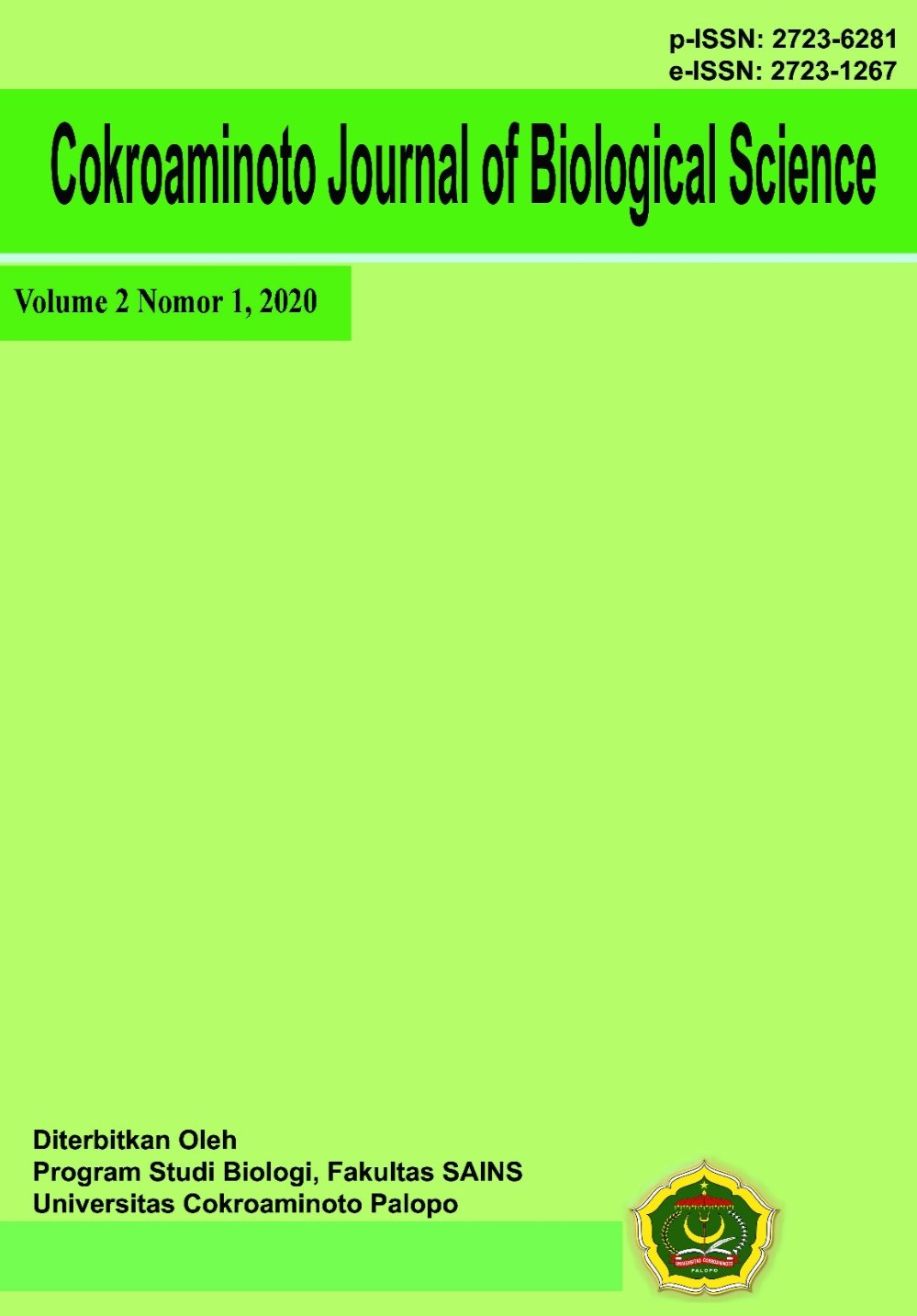Respon Anatomi Tanaman Bunga Matahari (Helianthus annuus L.) Terhadap Tembaga
Keywords:
Anatomi, Helianthus annuus L., tembagaAbstract
Penelitian ini bertujuan untuk mengetahui respon anatomis tanaman bunga matahari (H. annuus L.) terhadap tembaga dan dilakukan dengan menggunakan Rancangan Acak Lengkap yang terdiri dari 4 konsentrasi perlakuan logam Cu yaitu P0: 0 mg/L, P1: 100 mg/L, P2: 200 mg/L dan P3: 500 mg/L, dengan 5 ulangan untuk setiap perlakuan. Penelitian ini dilakukan dengan merendam biji bunga matahari kultivar dalam wadah berisi air hangat selama semalam kemudian ditanam pada polybag. Tanaman dipelihara secara intensif hingga berumur 2 minggu setelah tanam dan dilakukan aplikasi Cu. Logam Cu yang digunakan berupa garam CuSO4.5H2O. Setelah aplikasi Cu, dilakukan pengukuran pertumbuhan tanaman, pembuatan dan pengamatan preparat anatomi akar dan daun menggunakan optilab. Parameter penelitian meliputi parameter anatomis (akar terdiri dari tebal sel epidermis, tebal jaringan korteks, dan tebal berkas pengangkut; daun meliputi tebal sel epidermis atas dan bawah, tebal jaringan palisade, tebal jaringan spons, tebal berkas pengangkut, dan indeks stomata). Data hasil pengamatan disajikan dalam bentuk gambar dan pengukuran akan dianalisis menggunakan analisis sidik ragam dan diuji lanjut dengan Duncan Multiple Range Test dengan tingkat kepercayaan 95%. Hasil penelitian menunjukkan bahwa pemberian Cu berpengaruh terhadap anatomi tanaman bunga matahari dengan adanya kerusakan sel-sel epidermis dan korteks akar, penebalan berkas pengangkut akar, sel epidermis atas dan bawah daun, tebal jaringan palisade, jaringan spons, dan penebalan berkas pengangkut pada daun dan stomata daun bertipe fanerofor.
Downloads
References
[2] Fernandes, J. C., Henriques, F. S., 1991. Biochemical, physiological, and structural effects of excess copper in plants.Botanical Review., 57: 246–273.
[3] Muliadi, D., Lestiamy, Yanny., Sumarna, S. 2013. Fitoremediasi: Akumulasi dan Distribusi logam berat nikel, cadmium, dan chromium dalam tanaman Ipomea reptana. Prosiding seminar nasional Kimia dan Pendidikan Kimia. Sumatera barat.
[4] Mahmood, T., Islam, K. R., Muhammad, S. 2007. Toxic effects of heavy metal on early growth and tolerance of cereal crops. Pakistan Journal of Botany., 39: 451-462.
[5] Lahuddin, 2007. Aspek Unsur Mikro Dalam Tanah. Pidato Pengukuhan Jabatan Guru Besar Tetap. Universitas Sumatra Utara.
[6] Yruela, I. 2005. Copper in plants. Brazilian Journal of Plant Phisiology., 17: 145-156.
[7] Jadia, C. D., and Fulekar, M. H. 2009. Phytoremediation of heavy metals: Recent techniques. African Journal of Biotechnology., 8: 921-928.
[8] Hariana, H. A., 2007. Tumbuhan Obat dan Khasiatnya. Penebar Swadaya, Jakarta.
[9] Saidi, I., Nawel, N., Djebali, W. 2014. Role of selenium in preventing manganese toxicity in sunflower (H. annuus L.) seedling. South African Journal of Botany., 94: 88-94.
[10] Ruzin, S. E. 1999. Plant microtechnique and microscopy. Oxford University Press, London.
[11] Gomez, K. A., and Gomez A. A. 2010. Prosedur statistik untuk penelitian pertanian. Penerbit Universitas Indonesia, Jakarta.
[12] Fahn, A. 1991. Anatomi Tumbuhan. UGM Press, Yogyakarta.
[13] Gomez, M. P., Marques, T. C. L. L. S. M., Noguiera, E. M., De castro, E. M., Soares, A. M. 2011. Ecophysiological and anatomical changes due to uptake and accumulation of heavy metal in Bracharia decumbens. Journal Science Agricultural., 68: 566-573.
[14] Lux, A. A., Sottnikova, A., Opatrna, J., Greger, M. 2004. Differences in struture of adventitions roots in Salix clones with contrasting characteristics of cadmium accumulation and sensitivity. Physiologia Plantarum., 120: 537-545.
[15] Boojar, M., Goodarzi, F. 2007. The copper tolerance strategies and the role of antioxidative enzyme in tree plant species grown on copper mine. Chremospere., 67: 2138-2147.
[16] Sebastiani, L., Francini, A., Romeo, S., Ariani, A., Minocci, A. 2014. Heavy metals stress on poplar : molecular and anatomical modifications. Springer, Italy.
[17] Nugroho, L. H., Purnomo., Sumardi, I. 2010. Struktur dan Perkembangan Tumbuhan.Penebar swadaya, Depok.
[18] Al-Saadi, S. A. A. M., Al-Asaadi, W. M., Al-Waheeb, A. N. H. 2013. The effect of some heavy metals accumulation on physiological and Anatomical characteristic of some Potamogeton L. plant. Journal of Ecology and Environmental Sciences., 1: 100-108.
[19] Setia, R.C., and Bala, R. 1994. Anatomical Changes in root and stem of wheat (Triticum aestivum L.) in response to different heavy metals. Phytomorphology., 44: 95-104.
[20] Panou-Filotheou, H., Bosabalidis, A. M., 2004. Root structural aspects associated with copper toxicity in oregano (Origanum vulgare subsp. hirtum). Plant Science., 166: 1497-1504.
[21] Fernandes, J. C., Henriques, F. S., 1991. Biochemical, physiological, and structural effects of excess copper in plants.Botanical Review., 57: 246–273.
Downloads
Published
How to Cite
Issue
Section
License
In submitting the manuscript to the journal, the authors certify that:
- They are authorized by their co-authors to enter into these arrangements.
- The work described has not been formally published before, except in the form of an abstract or as part of a published lecture, review, thesis, or overlay journal.
- That it is not under consideration for publication elsewhere,
- That its publication has been approved by all the author(s) and by the responsible authorities – tacitly or explicitly – of the institutes where the work has been carried out.
- They secure the right to reproduce any material that has already been published or copyrighted elsewhere.
- They agree to the following license and copyright agreement.
License and Copyright Agreement
Authors who publish with this journal agree to the following terms:
- Authors retain copyright and grant the journal right of first publication with the work simultaneously licensed under Creative Commons Attribution License (CC BY 4.0) that allows others to share the work with an acknowledgment of the work's authorship and initial publication in this journal.
- Authors are able to enter into separate, additional contractual arrangements for the non-exclusive distribution of the journal's published version of the work (e.g., post it to an institutional repository or publish it in a book), with an acknowledgment of its initial publication in this journal.
- Authors are permitted and encouraged to post their work online (e.g., in institutional repositories or on their website) prior to and during the submission process, as it can lead to productive exchanges, as well as earlier and greater citation of published work.

